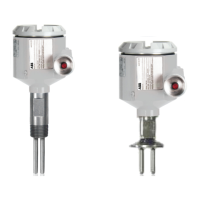Operating instruction manual | TX Thermal Disperson Level Switches 3
1.0 PRINCIPLE OF OPERATION
ABB’s thermal dispersion switch consists of two temperature sensors (Resistance Temperature Detectors), heater,
power supply, amplier, current generator, comparator and a relay (DPDT) for output. The type of temperature sensor
used is either a silicon semi-conductor, which is used on the standard units, or a platinum RTD which is used for high
temperature applications (see ordering options on data sheets). The two sensors are separated a short distance apart
from each other. The sensors are paired to track each other with temperature. These sensors have a resistance that is
proportional to their temperature and are known for their accuracy over a wide temperature range.
One part of the probe contains a heating element that raises the temperature of the sensor (active sensor) to a
temperature above the temperature of the medium. The other sensor (reference sensor) acts as a benchmark by
measuring the temperature of the medium. The switch can be thought of as a mass ow meter.
A constant current source is passed through both sensors to create a voltage differential that is proportional to the
amount of heat absorbed or released by the sensors. As the medium begins to rise or ow against the probes, the
molecules of the medium absorb more heat from the active sensor and the voltage differential begins to drop or as the
ow rate increases, the voltage differential will decrease (inverse relationship).
This is the basic principal behind thermal dispersion, which allows the conguration of the instrument to trip on ow,
level or temperature, to a set point or a combination of set points. The switch can be set to respond immediately to
changes in level, ow or temperature. However, as you decrease the response time, the recovery time increases.
There is an inherent time factor in any thermal dispersion switch due to the thermal conductivity of the medium, the type
of metal used and the cross sectional area of the metal surrounding the sensors. The response time can be adjusted
in a level or no-ow/ow application. But in a ow rate application, interface application or temperature application,
there is no time compensation and the unit will
not respond immediately. (See Data Sheet for
specications.)
A temperature change to the process or an
atmospheric temperature change will not affect
the setting because a change to the reference
sensor will also effect the active sensor. This
will result in an unchanged delta voltage and
therefore no change in state.
ABB’s line of thermal dispersion switches, the
TX, TQ, TS and IX are all analog switches.
This makes it a simple switch, a rugged switch,
and can be two distinct switches contained in
one housing.

